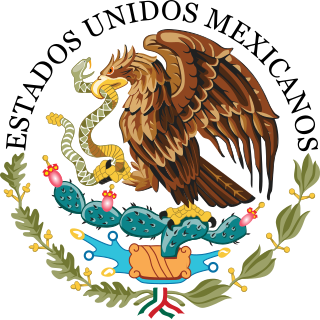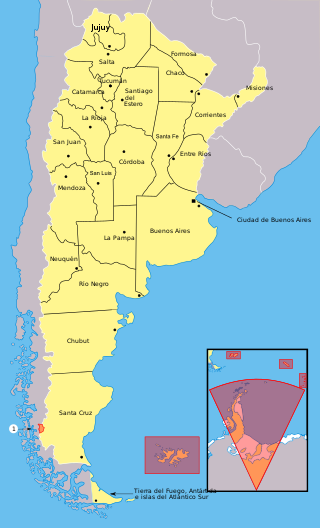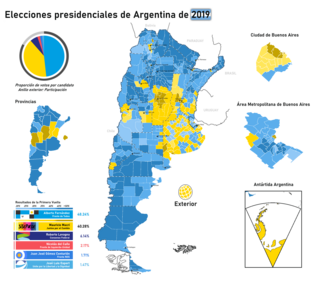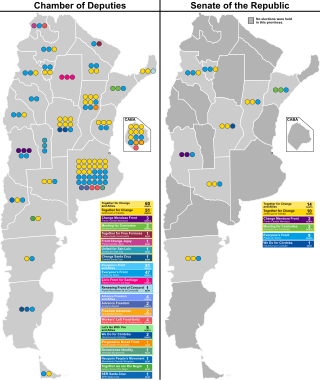The politics of Argentina take place in the framework of what the Constitution defines as a federal presidential representative democratic republic, where the President of Argentina is both Head of State and Head of Government. Legislative power is vested in the two chambers of the Argentine National Congress. The Judiciary is independent, as are the Executive and the Legislature. Elections take place regularly on a multi-party system.

The president of Argentina is both head of state and head of government of Argentina. Under the national constitution, the president is also the chief executive of the federal government and commander-in-chief of the armed forces.

Argentina is divided into twenty-three federated states called provinces and one called the autonomous city of Buenos Aires, which is the federal capital of the republic as decided by the Argentine Congress. The provinces and the capital have their own constitutions and exist under a federal system.

Manuel Pedro Quintana Sáenz was the President of Argentina from 12 October 1904 to 12 March 1906. He died in office.

The Chamber of Deputies, officially the Honorable Chamber of Deputies of the Argentine Nation, is the lower house of the Argentine National Congress. It is made up of 257 national deputies who are elected in multi-member constituencies corresponding with the territories of the 23 provinces of Argentina by party list proportional representation. Elections to the Chamber are held every two years, so that half of its members are up in each election, making it a rare example of staggered elections used in a lower house.

The Honorable Senate of the Argentine Nation is the upper house of the National Congress of Argentina.
At the national level, Argentina elects a head of state and a legislature. The franchise extends to all citizens aged 16 and over, and voting is mandatory for all those who are between 18 and 70 years of age.

The National Congress of Argentina is the legislative branch of the government of Argentina. Its composition is bicameral, constituted by a 72-seat Senate and a 257-seat Chamber of Deputies. The Senate, whose members are elected to six-year terms renewable by thirds each two years, consists of three representatives from each province and the federal capital. The Chamber of Deputies, whose members are elected to four-year terms, is apportioned according to population, and renews their members by a half each two years.

The government of the Philippines has three interdependent branches: the legislative, executive, and judicial branches. The Philippines is governed as a unitary state under a presidential representative and democratic constitutional republic in which the president functions as both the head of state and the head of government of the country within a pluriform multi-party system.
The Constitution of the Argentine Nation is the basic governing document of Argentina, and the primary source of existing law in Argentina. Its first version was written in 1853 by a constitutional assembly which gathered in Santa Fe; the doctrinal basis was taken in part from the United States Constitution. It was then reformed in 1860, 1866, 1898, 1949, 1957, and the current version is the reformed text of 1994. It's the seventh oldest national constitution currently in effect being ratified on May 1, 1853.
Argentina held national parliamentary elections on Sunday, 23 October 2005. For the purpose of these elections, each of the 23 provinces and the Autonomous City of Buenos Aires are considered electoral districts.

The current Constitution of Argentina dates from 1853. The Constitution of Argentina of 1853 was approved in 1853 by almost all of the provincial governments at that moment with the exception of Buenos Aires Province, which remained separate from the Argentine Confederation until 1859. After several modifications to the original constitution and the return of power to Buenos Aires' Unitarian Party, it was sanctioned on May 1, 1853, by the Constitutional Convention gathered in Santa Fe, and it was promulgated by the provisional director of the national executive government Justo José de Urquiza, a member of the Federalist Party. Following the short-lived constitutions of 1819 and 1826, it was the third constitution in the history of the country.

The Battle of Pavón, a key battle of the Argentine Civil Wars, was fought in Pavón, Santa Fé Province, Argentina on 17 September 1861 between the Army of the State of Buenos Aires and the Army of Republic of the Argentine Confederation. The withdrawal of Urquiza left the field to Mitre.

The Federal Government of Mexico is the national government of the United Mexican States, the central government established by its constitution to share sovereignty over the republic with the governments of the 31 individual Mexican states, and to represent such governments before international bodies such as the United Nations. The Mexican federal government has three branches: executive, legislative, and judicial and functions per the Constitution of the United Mexican States, as enacted in 1917, and as amended. The executive power is exercised by the executive branch, which is headed by the president and her Cabinet, which, together, are independent of the legislature. Legislative power is vested upon the Congress of the Union, a bicameral legislature comprising the Senate and the Chamber of Deputies. Judicial power is exercised by the judiciary, consisting of the Supreme Court of Justice of the Nation, the Council of the Federal Judiciary, and the collegiate, unitary, and district courts.

The Argentine Constitution of 1819 was a Constitution drafted by the Congress of Tucumán in 1819, shortly after the Argentine War of Independence. It was promoted by Buenos Aires but rejected by the other provinces and did not come into force.

General elections were held in Argentina on Sunday, 23 October 2011. Incumbent president Cristina Fernández de Kirchner of the Front for Victory won in a landslide, with 54.11% of the vote, securing a second term in office. The Front for Victory won just over half of the seats in the National Congress. As of 2023, this marked the last time the vice president-elect wasn't a female.

Most Provinces of Argentina held executive and legislative elections during 2011, electing governors and provincial legislatures. The only exceptions are Santiago del Estero Province, whose executive and legislative elections were elected in 2012; and Corrientes Province, whose gubernatorial election took place in 2013.

Legislative elections were held in Argentina on 22 October 2017 to elect half of the Chamber of Deputies and one third of the Senate. The result was a victory for the ruling Cambiemos alliance, being the most voted force in 13 of the 24 districts.

General elections were held in Argentina on 27 October 2019, to elect the president of Argentina, members of the national congress and the governors of most provinces.

Legislative elections were held in Argentina on 14 November 2021. Half of the seats in the Chamber of Deputies and a third of the seats in the Senate were renewed. The election had previously been scheduled to take place on 24 October 2021, but was postponed due to the COVID-19 pandemic in Argentina.




























